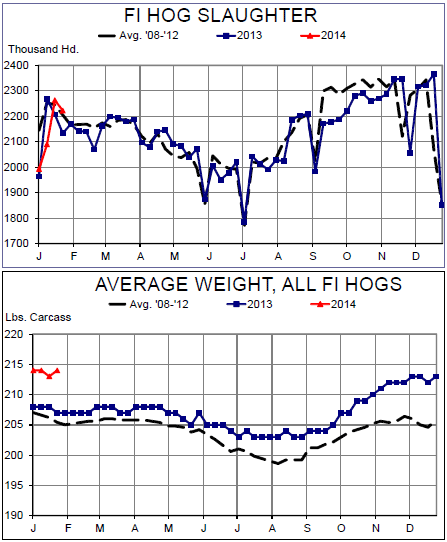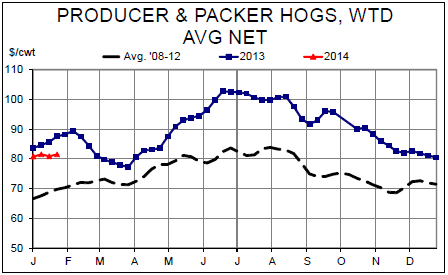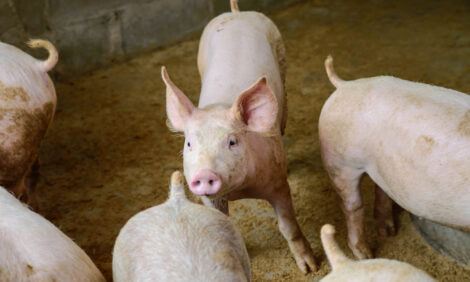



CME: Weights Real 'Supply Story' for Hogs in 2014
US - We’ve sort of been beef-centric in The Daily Livestock Report in recent days — at least when we weren’t talking about the Farm Bill. And for good reason. When prices of any products of interest reach record levels, the occasion is worthy of attention, write Steve Meyer and Len Steiner.And that is especially true when the run is either larger or timed differently than expected. Both, of course, apply to recent changes in the beef sector. But there is a world outside of beef and politics so let’s catch up a bit on happenings in the hog and pork sectors.
Hog numbers have, in sum, been very close to the levels indicated by the December Hogs and Pigs report but the pattern of the marketings has been impacted by weather and, no doubt, the culmination of PEDv losses last summer. FI slaughter totals since the first week of December have exceeded year-ago levels by 0.4 per cent and our forecast levels by 0.6 per cent. That last number is close enough to leave us at this point comfortable with the December inventory numbers. The weather-shortened run of the week of 10 January has been predictably followed by two larger-than-expected runs the past two weeks. This week’s total through Thursday was 1.572 million head, well short of last year’s 1.660 million head. We would be surprised if the difference will be made up by a larger Saturday run.

But the real "supply story" for hogs this year is weights. Virtually every industry observer expected weights to grow when it became apparent that last year’s crop was a good one and significantly lower feed costs were coming. But the size of the weight increase has been surprising with the extra growth driven, we believe, by efforts on the part of some producers to make up for PEDv losses by taking hogs heavier. The average carcass weight of all hogs harvested in federally-inspected (FI) plants has exceeded 212 pounds in all but one week since 1 December. So far this year, all-hog weights (for which we only have weekly data) are up 3.4 per cent from one year ago. Daily data for producer-sold barrows and gilts indicate they are 3.1 per cent heavier than last year while packer-sold barrows and gilts are 2.8 per cent heavier. Those year-on-year comparisons surprised us a bit since the focus of this weight discussion has been on 217-lb.-plus packer-owned pigs. But the data say that producers are as much or more responsible as packers for the year-on-year increase.

Put the two supply factors together and we find that pork production has exceeded last year by 1.3 per cent so far in 2014. Like slaughter, that figure was significantly short of last year the week of January 10 but has grown the past two weeks. The December Hogs and Pigs report suggests that hog numbers will be, on average, very close to year-ago levels through February before declining slightly in March. Higher weights will more than make up for the reduction, however, suggesting that pork production will continue to run one to three per cent higher than last year for the next few weeks.
The impact on prices has been predictable. While cutout values have tracked last year almost precisely, hog prices have remained near $80/cwt. carcass, roughly five per cent below last year’s level. Seasonal strength will take values above last year’s level by mid- February, partly due to last year’s sharp price break when Russia banned U.S. pork over alleged concerns about ractopamine. We still expect PED losses to push summer highs at least as high as in 2013.








